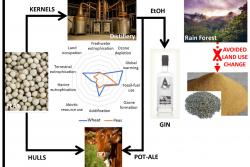How your choice of afternoon tipple could help save the rainforest
 It’s the season for a cold afternoon ‘gin & tonic’ on ice. We may question the health impact of one too many, but what is the environmental footprint of that classically delicious aperitif? An international team of researchers teamed up with a pioneering distillery manager to answer this question in a study published in the scientific journal Environment International.
It’s the season for a cold afternoon ‘gin & tonic’ on ice. We may question the health impact of one too many, but what is the environmental footprint of that classically delicious aperitif? An international team of researchers teamed up with a pioneering distillery manager to answer this question in a study published in the scientific journal Environment International.
The process of producing gin includes many steps. Firstly, cultivation of wheat includes ploughing and application of agricultural inputs such as synthetic nitrogen fertiliser. Secondly, following harvest, seed dressing (or cleaning) and transportation, there is the fermentation and distillation stage which includes milling, enzyme addition and heating. Finally, the flavoured gin must be packaged in bottles and boxes for distribution to consumers. The greenhouse gas (GHG) cost of all these steps was calculated to be 2.3 kg CO2 equivalent (eq.) per 70 cl bottle of gin, or 0.16 kg CO2 eq. per large measure (50 ml). “In real tangible terms of climate change impact, sipping 2 units of gin is similar to consuming a small serving (150 ml) of milk, or to driving one km in a petrol car”, concludes Theophile Lienhardt, lead author of the study.
However, what if that gin was made from peas? Arbikie Distillery in Scotland have run trials in which the kernels of dried, de-hulled peas (Pisum sativum L.) are milled and fermented in place of mashed wheat grain.
 Kirsty Black, manager of the Arbikie Distillery, provides reassurance to gin connoisseurs: “Following two distillations to produce a neutral base spirit, botanicals including juniper and coriander can be used to produce a final gin that retains the same sumptuous, aromatic flavour as gin made from cereal grain spirit.”
Kirsty Black, manager of the Arbikie Distillery, provides reassurance to gin connoisseurs: “Following two distillations to produce a neutral base spirit, botanicals including juniper and coriander can be used to produce a final gin that retains the same sumptuous, aromatic flavour as gin made from cereal grain spirit.”
The study was part of the pan-European project “TRansition paths to sUstainable legume based systems in Europe: TRUE” led by Dr Pietro Iannetta, an agroecologist at the James Hutton Institute. “We found that the environmental footprint of pea gin was significantly lower than for wheat gin across 12 of 14 environmental impacts evaluated, from climate change, through water and air pollution, to fossil energy consumption”, noted Dr Iannetta.
Professor Mike Williams from Trinity College Dublin explains, “Peas fix nitrogen from the atmosphere, and therefore don’t require applications of polluting synthetic nitrogen fertilisers. Furthermore, pea hulls and distillery co-products provide protein-rich animal feeds that can replace soybean imported from Latin America, where soybean cultivation is driving deforestation.”
Co-products from one litre of pea gin substitute up to 0.66 kg of soybean animal feed, twice as much as from wheat gin, and could help to reduce Europe’s high dependence on imported protein. Amazingly, potential avoidance of GHG emissions from substituted soybean cultivation, deforestation, processing and transport can exceed the GHG emissions arising from production of the pea gin itself, making the gin from peas carbon neutral.
“Of course, if we wanted to dramatically shrink our environmental footprint and reduce deforestation, we could eat those peas directly to provide our protein and fibre requirements, instead of drinking gin and eating beef fed on the co-products”, cautions Dr David Styles, lecturer in life cycle assessment at Bangor University and NUI Galway. Nevertheless, for those moments of social interaction sipping a delicious G&T, Arbikie Distillery are working to ensure that a responsible tipple need not cost the earth, literally. …
Publication date: 10 July 2019
